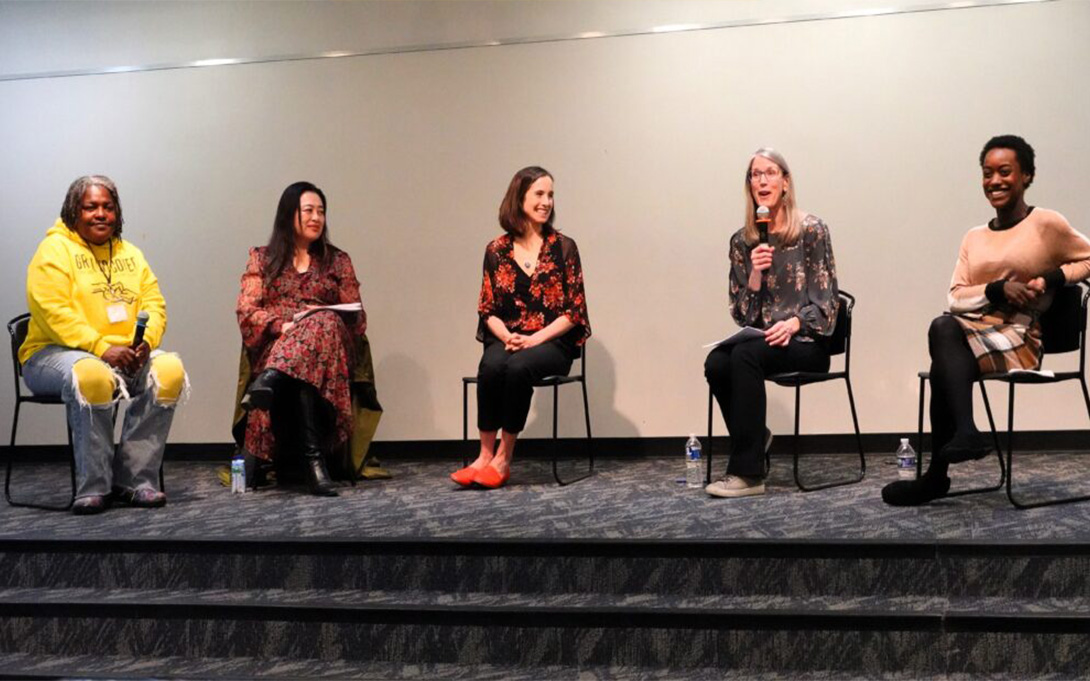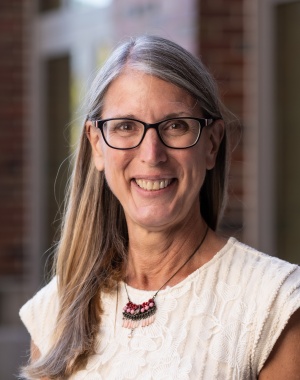
On May 8, about 25 community members gathered at the downtown Ann Arbor District Library to hear firsthand how guaranteed income is supporting local entrepreneurs and gig workers. The event spotlighted Guaranteed Income to Grow – Ann Arbor (GIG A2), a pilot program that provides $528 per month in unconditional cash payments to 100 self-employed and low-income residents for two years.
Hosted by Poverty Solutions at the University of Michigan in partnership with Groundcover News, the event featured gig workers, city leaders, and researchers discussing the role of cash assistance in supporting financial stability, business growth, and community well-being.
About GIG A2
Launched in January 2024, GIG A2 is funded by federal American Rescue Plan Act (ARPA) dollars allocated by the City of Ann Arbor, with additional support from the Ann Arbor Area Community Foundation. Participants were randomly selected from a pool of eligible applicants engaged in gig work, self-employment, or micro-entrepreneurship — from rideshare drivers and artists to caregivers and street-based vendors.
The program is part of a national wave of over 100 guaranteed income pilots across the U.S. What makes GIG A2 unique is its specific focus on people whose work falls outside traditional employment systems and who often lack access to benefits like paid time off or health insurance.
“Guaranteed income is about providing a floor under people — so no one falls through,” said Kristin Seefeldt, acting faculty director of Poverty Solutions and lead researcher on GIG A2. “We’re studying how this kind of support affects income volatility, mental health, and the ability to plan ahead.”
Entrepreneurship and Stability
Panelist Jaydan Lightfoot, a GIG A2 participant, shared how the monthly income has helped her navigate financial uncertainty and invest in herself. Lightfoot runs a faith-based media and event production company. She said the payments allowed her to purchase new equipment and host her first community event for young mothers.
“This money helped me get equipment and the motivation to keep going,” Lightfoot said. “I have bills and family responsibilities — this allowed me to dedicate funds to growing my business.”
Felicia Wilbert, a longtime gig worker and Groundcover vendor, offered perspective on the challenges of self-employment without guaranteed income. She shared that her monthly Social Security income is not enough to cover rent in Ann Arbor, where even modest apartments often exceed $1,000 per month.
“If I get a job, they take a dollar from my benefits for every dollar I earn,” Wilbert said, reflecting on the challenges of surviving on Social Security.
She emphasized that Groundcover — where she’s worked as a vendor for over a decade — has been a vital source of income and dignity.
“It’s a bridge that helped me breathe,” she said.
Understanding the Policy Value
While some panelists focused on personal impact, researchers highlighted what distinguishes guaranteed income from other types of public assistance.
“Most public benefits are conditional and restricted. You often have to prove how poor you are, work a certain number of hours, or spend the money in specific ways,” said Rebeccah Sokol, a U-M researcher working on the GIG A2 evaluation with Seefeldt and William Lopez. “With guaranteed income, the money is unconditional and unrestricted. People decide what matters most to them — whether it’s paying bills, saving for emergencies, or helping a family member.”
Sokol added that many participants reported using the payments to cover essentials not supported by other programs — such as fixing a broken window, buying clothing, or investing in creative work.
“This kind of flexibility allows people to meet their own priorities, not just what the system allows,” Sokol said.
The GIG A2 team is conducting surveys and interviews with people receiving the monthly guaranteed income payments as well as a comparison group to measure the program’s impact on financial stress, housing, work patterns, and community participation.
Why Gig Work?
Former Ann Arbor City Councilmember Linh Song, who helped initiate the pilot during her time in office, spoke about how GIG A2 came to life through the city’s ARPA engagement process.
“During the pandemic, we heard from residents who were falling through the cracks. This was a fast, flexible response to what they told us they needed — support without stigma,” Song said.
She noted that Ann Arbor’s high cost of living has made it harder for many Black, brown, and working-class residents to remain in the city, and that gig work has become a common, though often insecure, way to earn a living.
“We wanted to show that the people keeping this city going — the drivers, artists, caregivers, and entrepreneurs — deserve support and trust,” Song said.
Looking Ahead
The GIG A2 pilot is scheduled to run through December 2025. While the funding is time-limited, researchers and community members alike emphasized the need to explore how guaranteed income programs might be sustained or expanded through future investments from local governments or philanthropy.
Joe Woods, another GIG A2 participant who attended the May 8 community conversation, shared that the monthly income allowed him to move into a larger apartment and launch his Joe T-Shirts clothing brand.
“It gave me a chance to live,” he said. “This program helped me take a step forward.”
Panelists encouraged attendees to stay engaged with city and county budget conversations and to share their experiences with local leaders.
“This pilot shows what’s possible when we trust people,” Song said. “Now the question is — what comes next?”
This article was written by Yinqi Chen, Poverty Solutions
